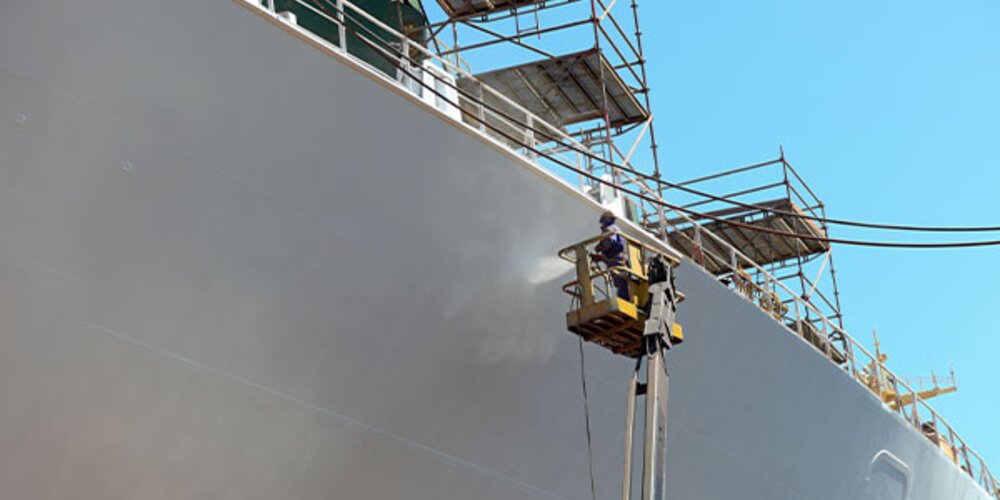Browse our services
Explore how Brookes Bell can help you
Find an expert
Meet our team, find and expert and connect
Contact us
Get in touch, we're here to help

Judith Fergus leads Brookes Bell’s paints and coatings division. With many years of experience in the marine sector, Judith and her team provide independent advice on many aspects of paint and coating related problems covering everything from new build supervision through to vessel drydocking surveys. Here she talks about some of the team’s current work.
At the moment, most of our work is specific root cause analysis of coating failures. Generally, we are instructed by shipowners, P&I clubs or insurers, and our team’s investigations are working to find out the root cause of a problem, how to fix, compensate or learn from any underlying issues, and how to prevent future incidents.
The coating failure could be on a yacht or cargo ship and our investigations typically involve a multi-disciplinary approach, with our coatings experts consulting with our master mariners, engineers, fuel chemists or cargo scientists.
On a cargo ship it is most likely to be the antifouling on the underwater hull, or the paint coating in a chemical tank or cargo hold.
At the moment, we are working on several cases of severe cargo tank coating blistering. With these, the first step is to complete a physical or remote survey, where samples of the blister fluid and paint flakes will be taken. During the inspection, paint flakes are collected from the affected area along with fluids from any available coating blisters, following a strict protocol.
The flakes are then sent to the Brookes Bell independent laboratory for optical microscopy, SEM-EDX (scanning electron microscopy (SEM) with energy dispersive X-Ray analysis (EDX) and FT-IR (Fourier-transform infrared spectroscopy). Using this detailed analysis, our paint experts will be able to confirm the coating thickness, and the type and mechanism of the coating failure.
Then we analyse extensive documentation provided by the client – the physical paper records and online data. Our investigations review a wide range of information to identify the key evidence which will help us to discern exactly what has happened. We need to know what started the blistering – was it the surface preparation or was it the cargo carried? By reviewing the large volumes of information, we can rapidly focus on what is relevant and what is not, thanks to our many years of experience and specialist qualifications.
I will examine the coating diaries, to see how the coating was applied at the newbuilding stage, I will review the cargo list, to see what each tank has carried and I will consult with Brookes Bell’s tanker experts to verify the tank washing methods. We know what to look for, there are about 20-25 potential key pointers and if they are not clear in the available documentation then we will talk to the client, making focussed requests for further information.
Some gaps may remain, as the records are not always kept as well as one would like or completed as thoroughly as one would hope. Sometimes retained samples are not labelled correctly, or identified only by a date or code, so it can be difficult to locate the correct information. However, using our experience and the multi-disciplinary support available in Brookes Bell, we can draw the maximum evidential value from whatever information can be obtained.
As our specialist expertise in coatings becomes ever more widely recognised, it is opening up other areas of business. It is not just big ships. We are working more closely with the superyacht team using advanced non-destructive testing services which offer up some exceptional insights.
Using NDT techniques, our Engineers and Material Scientists can look underneath the yacht’s coating, examining any corrosion or wall loss, while I focus on the paint, considering the whole paint scheme – where it has failed and how it has failed.
The paints and coatings on yachts are very different to ships with much greater emphasis on the finish – it is a very high shine gloss. There will be lots of paint layers, with primers, fairing (fillers) and a topcoat with the very uppermost layers as shiny as possible.
Ship paint coatings are much more functional, they are simply there to do a job and to minimise maintenance costs. An exterior cosmetic coat aims to give excellent durability with long term protection, whereas a cargo hold paint would need to be abrasion resistant to cope with any hard cargoes such as iron ore and coal being loaded and unloaded.
The independent Brookes Bell laboratory on the Wirral offers many new resources. We can turn around samples very fast and our analysts and in-house experts work in total collaboration, offering unrivalled expertise and insight.
We discuss what I am looking for and why I want specific tests conducted and in turn, our analysts may suggest something else to test for or they might note something else that could be relevant, that would otherwise be missed. For example, if I want to know how much copper is in an antifouling paint sample, they can tell me, but they may also ask why I need to know and then suggest different angles and aspects worth looking into.
Brookes Bell’s metallurgical and analytical chemistry expertise is a huge benefit to much of the work undertaken, providing true interdisciplinary synergy. It’s a real bonus, working with any other external lab, I would never get access to such a group of experts with such extensive experience.